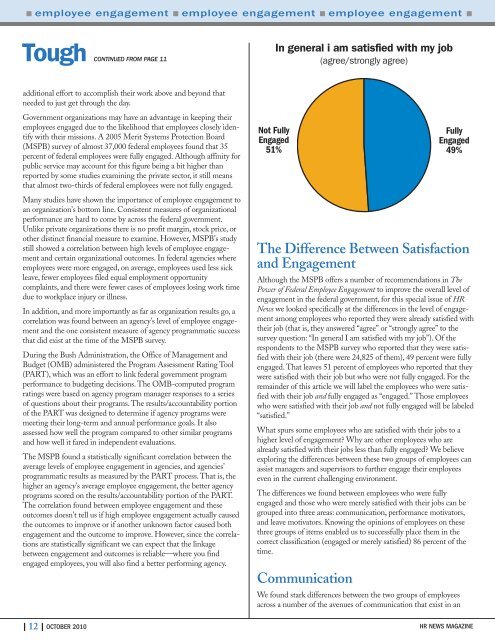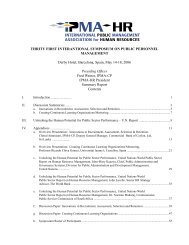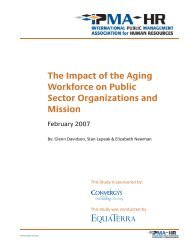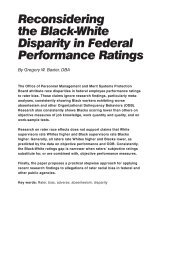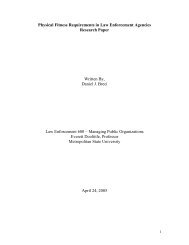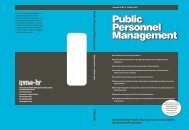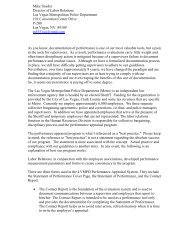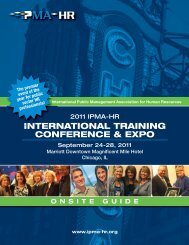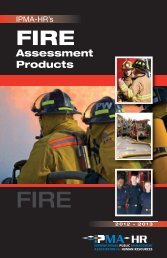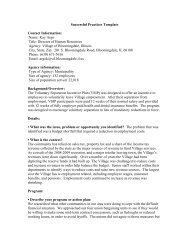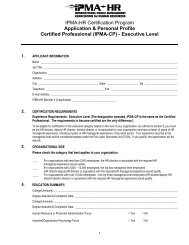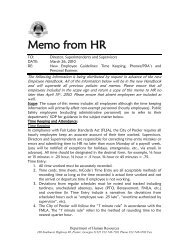October 2010 issue of HR News magazine - IPMA
October 2010 issue of HR News magazine - IPMA
October 2010 issue of HR News magazine - IPMA
You also want an ePaper? Increase the reach of your titles
YUMPU automatically turns print PDFs into web optimized ePapers that Google loves.
■ employee engagement ■ employee engagement ■ employee engagement ■<br />
Tough CONTINUED<br />
FROM PAGE 11<br />
additional effort to accomplish their work above and beyond that<br />
needed to just get through the day.<br />
Government organizations may have an advantage in keeping their<br />
employees engaged due to the likelihood that employees closely identify<br />
with their missions. A 2005 Merit Systems Protection Board<br />
(MSPB) survey <strong>of</strong> almost 37,000 federal employees found that 35<br />
percent <strong>of</strong> federal employees were fully engaged. Although affinity for<br />
public service may account for this figure being a bit higher than<br />
reported by some studies examining the private sector, it still means<br />
that almost two-thirds <strong>of</strong> federal employees were not fully engaged.<br />
Many studies have shown the importance <strong>of</strong> employee engagement to<br />
an organization’s bottom line. Consistent measures <strong>of</strong> organizational<br />
performance are hard to come by across the federal government.<br />
Unlike private organizations there is no pr<strong>of</strong>it margin, stock price, or<br />
other distinct financial measure to examine. However, MSPB’s study<br />
still showed a correlation between high levels <strong>of</strong> employee engagement<br />
and certain organizational outcomes. In federal agencies where<br />
employees were more engaged, on average, employees used less sick<br />
leave, fewer employees filed equal employment opportunity<br />
complaints, and there were fewer cases <strong>of</strong> employees losing work time<br />
due to workplace injury or illness.<br />
In addition, and more importantly as far as organization results go, a<br />
correlation was found between an agency’s level <strong>of</strong> employee engagement<br />
and the one consistent measure <strong>of</strong> agency programmatic success<br />
that did exist at the time <strong>of</strong> the MSPB survey.<br />
During the Bush Administration, the Office <strong>of</strong> Management and<br />
Budget (OMB) administered the Program Assessment Rating Tool<br />
(PART), which was an effort to link federal government program<br />
performance to budgeting decisions. The OMB-computed program<br />
ratings were based on agency program manager responses to a series<br />
<strong>of</strong> questions about their programs. The results/accountability portion<br />
<strong>of</strong> the PART was designed to determine if agency programs were<br />
meeting their long-term and annual performance goals. It also<br />
assessed how well the program compared to other similar programs<br />
and how well it fared in independent evaluations.<br />
The MSPB found a statistically significant correlation between the<br />
average levels <strong>of</strong> employee engagement in agencies, and agencies’<br />
programmatic results as measured by the PART process. That is, the<br />
higher an agency’s average employee engagement, the better agency<br />
programs scored on the results/accountability portion <strong>of</strong> the PART.<br />
The correlation found between employee engagement and these<br />
outcomes doesn’t tell us if high employee engagement actually caused<br />
the outcomes to improve or if another unknown factor caused both<br />
engagement and the outcome to improve. However, since the correlations<br />
are statistically significant we can expect that the linkage<br />
between engagement and outcomes is reliable—where you find<br />
engaged employees, you will also find a better performing agency.<br />
Not Fully<br />
Engaged<br />
51%<br />
In general i am satisfied with my job<br />
(agree/strongly agree)<br />
The Difference Between Satisfaction<br />
and Engagement<br />
Although the MSPB <strong>of</strong>fers a number <strong>of</strong> recommendations in The<br />
Power <strong>of</strong> Federal Employee Engagement to improve the overall level <strong>of</strong><br />
engagement in the federal government, for this special <strong>issue</strong> <strong>of</strong> <strong>HR</strong><br />
<strong>News</strong> we looked specifically at the differences in the level <strong>of</strong> engagement<br />
among employees who reported they were already satisfied with<br />
their job (that is, they answered “agree” or “strongly agree” to the<br />
survey question: “In general I am satisfied with my job”). Of the<br />
respondents to the MSPB survey who reported that they were satisfied<br />
with their job (there were 24,825 <strong>of</strong> them), 49 percent were fully<br />
engaged. That leaves 51 percent <strong>of</strong> employees who reported that they<br />
were satisfied with their job but who were not fully engaged. For the<br />
remainder <strong>of</strong> this article we will label the employees who were satisfied<br />
with their job and fully engaged as “engaged.” Those employees<br />
who were satisfied with their job and not fully engaged will be labeled<br />
“satisfied.”<br />
What spurs some employees who are satisfied with their jobs to a<br />
higher level <strong>of</strong> engagement? Why are other employees who are<br />
already satisfied with their jobs less than fully engaged? We believe<br />
exploring the differences between these two groups <strong>of</strong> employees can<br />
assist managers and supervisors to further engage their employees<br />
even in the current challenging environment.<br />
The differences we found between employees who were fully<br />
engaged and those who were merely satisfied with their jobs can be<br />
grouped into three areas: communication, performance motivators,<br />
and leave motivators. Knowing the opinions <strong>of</strong> employees on these<br />
three groups <strong>of</strong> items enabled us to successfully place them in the<br />
correct classification (engaged or merely satisfied) 86 percent <strong>of</strong> the<br />
time.<br />
Communication<br />
Fully<br />
Engaged<br />
49%<br />
We found stark differences between the two groups <strong>of</strong> employees<br />
across a number <strong>of</strong> the avenues <strong>of</strong> communication that exist in an<br />
| 12 | OCTOBER <strong>2010</strong> <strong>HR</strong> NEWS MAGAZINE


